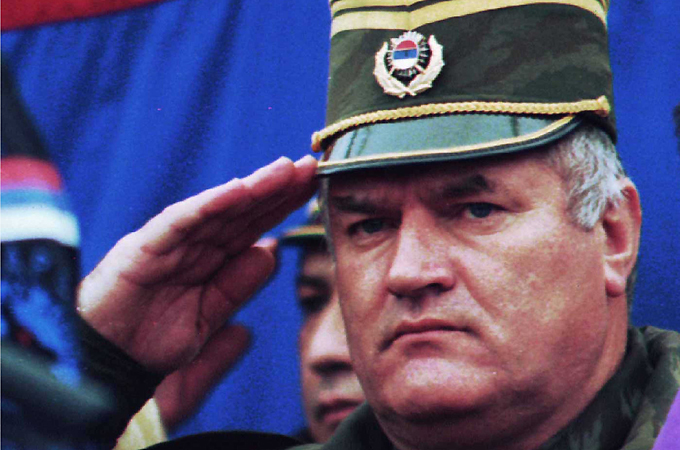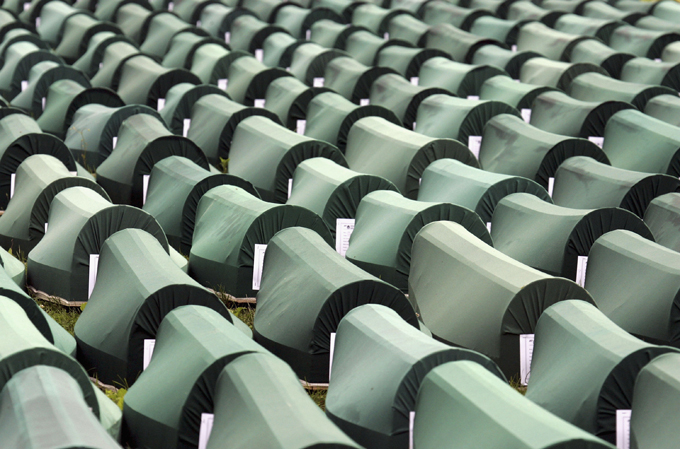Profile: Ratko Mladic
Ratko Mladic, the former head of the Bosnian-Serb army, was commander during the Srebrenica massacre.

 |
| Radko Mladic, pictured in Vlasenica, north-east of Sarajevo, on December 2, 1995 [Reuters] |
Ratko Mladic, the former Bosnian Serb military leader during the 1992-1995 Bosnian war, was indicted by the United Nations war crimes tribunal in 1995 on charges of genocide and other crimes against humanity.
Serbia announced his arrest on May 26, 2011.
“On behalf of the Republic of Serbia we announce that Ratko Mladic has been arrested,” Boris Tadic, the country’s president, said.
“Today we closed one chapter of our recent history that will bring us one step closer to full reconciliation in the region.”
Mladic is alleged to have been involved in the Srebrenica massacre of about 8,000 unarmed Bosnian Muslims in July 1995, and the siege of Sarajevo, in which more than 12,000 civilians died.
Until his arrest, he one of two last fugitives wanted by the International Criminal Tribunal for the former Yugoslavia (ICTfY), along with Goran Hadzic, a former Croatian Serb leader, who is believed to be in hiding in Serbia.
The charges against Mladic [PDF] include genocide, complicity in genocide, extermination and murder, deportation and inhumane acts, unlawfully inflicting terror upon civilians, cruel treatment, attacks on civilians and the taking of hostages.
Mladic was the military chief of Radovan Karadzic, the wartime Bosnian Serb political leader, who was captured in Belgrade in July 2008.
During his time as chief of staff of the army of Republika Srpska, Mladic is also charged with the killing, deportation and forcible transfer of non-Serbs in support of “ethnic cleansing” campaigns in Bosnia in 1992 and 1993.
The former military leader’s family sought to have Mladic declared officially dead in May 2010, claiming they had not seen him for seven years and that they wished to end the “harassment they are exposed to”.
Srebrenica massacre
The Srebrenica massacre is seen as the single worst atrocity in Europe since World War II.
| In depth: Srebrenica | |
| |
| Safe Haven: survivors return | |
| Inside Story: Serbia’s apology | |
| Veterans: The siege of Sarajevo | |
| Bosnia marks 15 years since massacre | |
| Rageh Omaar: The secret life of Karadzic |
In the five days after Bosnian Serb forces took control of the town, at least 8,000 Muslim men and boys, aged from 12 to 77, were murdered, after they were separated out for “interrogation for suspected war crimes” by the Serbs.
Mladic is accused of involvement in the torture, abuse, sexual violence and beatings of Bosnian Muslims, and of creating conditions in detention facilities “calculated to bring about the physical destruction of Bosnian Muslims”.
He also faces charges over attempts to conceal the executions of Bosnian Muslims in Srebrenica by reburying, in isolated locations, bodies exhumed from mass graves.
The indictment alleges that Mladic “was a member of a joint criminal enterprise whose objective was the elimination or permanent removal of Bosnian Muslim, Bosnian Croat, or other non-Serb inhabitants from large areas of (Bosnia and Herzegovina)”.
Military commander
Mladic was born in the village of Kalinovik, in Bosnia, then part of Yugoslavia, in 1942, and went on to become an officer in the Yugoslav People’s Army. His father was killed by pro-Nazi Croatian Ustasha troops in 1945.
As the country began to fall apart in 1991, he was posted to lead the Yugoslav army’s 9th Corps against Croatian forces at Knin.
Later, he took command of the Yugoslav army’s second military district, based in Sarajevo.
In May 1992, the Bosnian Serb assembly voted to create a Bosnian Serb army, appointing Mladic to the post of commander.
He was promoted to the rank of General Colonel in June 1994.
In March 1994, Mladic’s daughter Ana, a medical student, shot herself with her father’s pistol in Belgrade.
Mladic led Bosnian Serb troops throughout the 1992-1995 conflict.
At the end of the war, Mladic returned to Belgrade, where he went into hiding. Mladic was believed to be in or near the Serbian capital, under the protection of Slobodan Milosevic, the former Serbian president, until Milosevic’s arrest in 2001.
In 2004, it was reported that Mladic was being aided by Bosnian Serb military forces, while in 2008 Belgrade admitted he had been under military protection until mid-2002.
